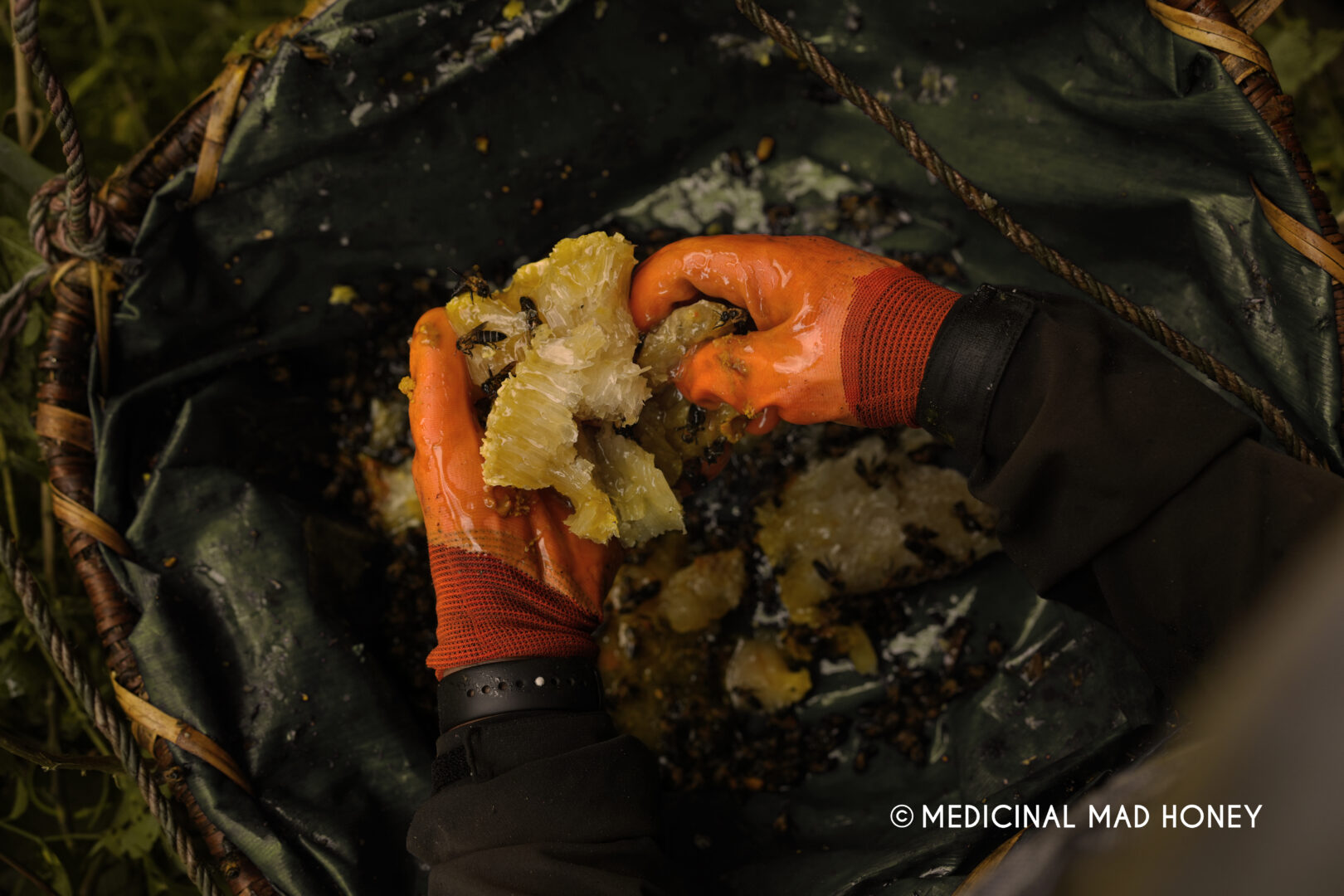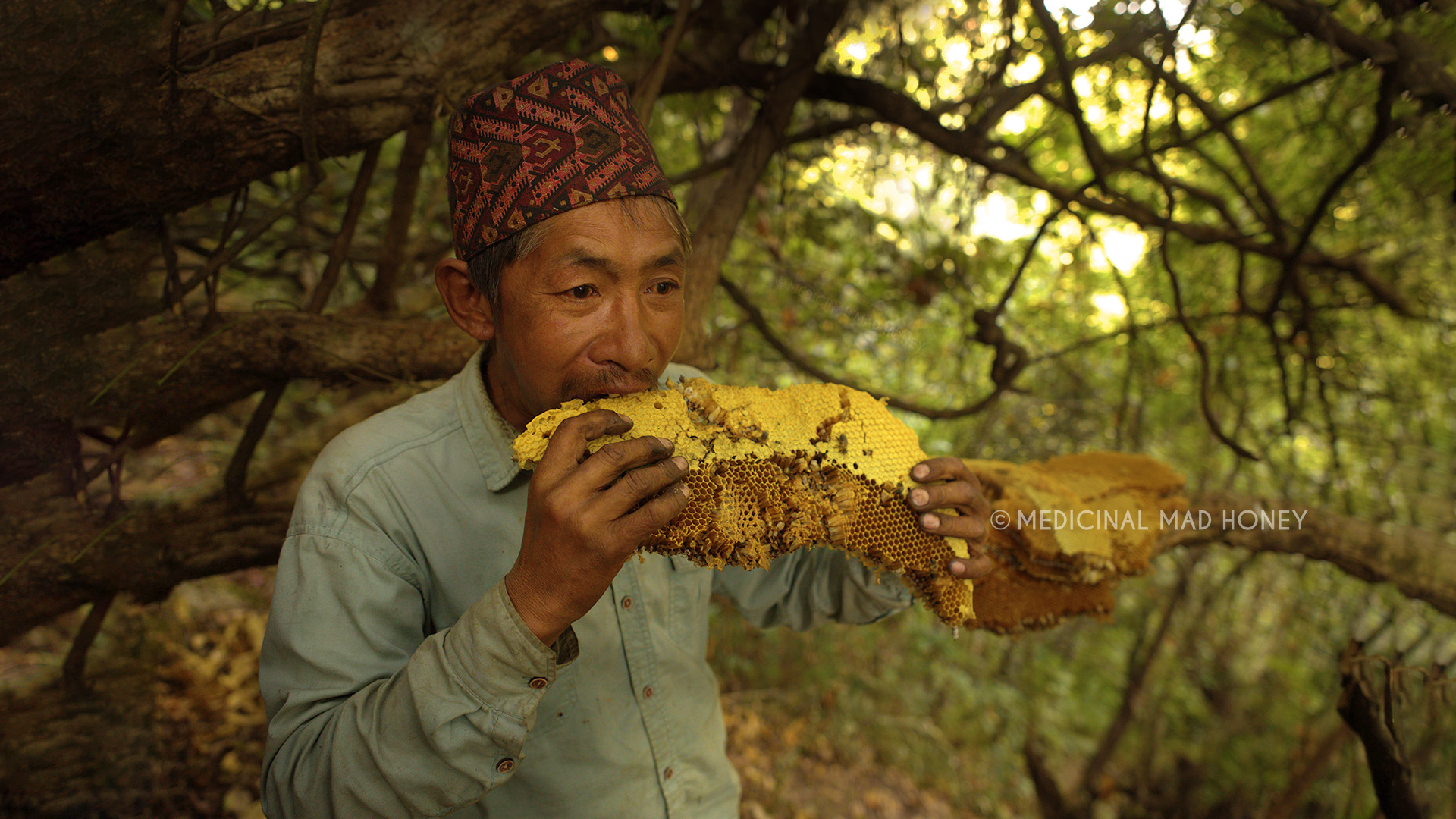Mad honey, also known as the ‘bhir maha’, is a unique honey from a remote village in Nepal. The Himalayan giant honey bee Apis Labriosa Dorsata produces mad honey by feeding on wildflowers and rhododendron flowers. It is a rarely found honey in the world that you can only find in countries like Turkey and Nepal. Also, it can be obtained from some parts of the Himalayas.
Gurungs are the skillful local tribesmen who are the masters of honey hunting. Since mad honey has been a staple in their local diet, they have grown up consuming it. Consequently, they had the chance to reap its benefits. They saw a noticeable elevation in their physical and mental energies.
Active Ingredients
 Ingredients in mad honey after fresh harvest
Ingredients in mad honey after fresh harvestJournal of Food Measurement and Characterization shows that the bee pollen gathered from the Rhododendron flower has a strong chemical profile. The researchers found 31 elements and 42 amino acids, 33 phenolics and various vitamins like C and B2, B5 and B6. Whereas, its nutrient profile comprises Magnesium (Mg), Phosphorus (P), Calcium (Ca) and Iron (Fe).
The plant pollen is the main source of protein for the honeybees and is also a source of essential amino acids such as arginine, histidine, lysine, tryptophan, etc.
Grayanotoxins
The Rhododendron family includes over 750 species where toxins grayanotoxins (GTXs) are common in many. In Turkey, five species of rhododendron flowers are present including R. ponticum (purple flower) and R. luteum (yellow flower) that grow from sea level to about 3200 meters in altitude.
Grayanotoxin is a neurotoxin found in the plant family Ericaceae (heather) including Rhododendron, Leucothoe and Kalmia. These toxins got their name from the Japanese plant Leucothoe grayana. Primarily the Japanese researchers discovered grayanotoxin I-III from Leucothoe grayana. Grayanotoxin IV was only found in the subsequent year 1964.
The toxin in the Rhododendron plants is found in the green plants and in their nectar, flower and pollen. The giant honeybees – Apis Dorsata Laboriosa collect toxin pollen and nectar to produce the mad honey honey.
Today, we can find grayanotoxin in its 18 forms each with its own distinct effects and benefits. However, in Turkey, only R. ponticum and R. luteum produce these toxins. Grayanotoxins I-IV are the most prominent ones with their different levels of toxicity. Grayanotoxin I affects atrioventricular conduction and sinoatrial nodes causing significant heart issues. In 1912, German phytochemist Otto Tunmann had to isolate grayanotoxin- I for its toxic properties.
Grayanotoxin II reduces the natural rhythm of the sinoatrial node by altering cell membrane permeability to sodium ions. The 2nd form of grayanotoxin has the least toxin out of all. Grayanotoxin III causes arrhythmias by triggering abnormal electrical activity in heart cells.
Recent studies have shown Rhododendron plants and their plants use chromatography-mass spectrometry (GC-MS) for toxicological analysis. However, liquid chromatography is also popular due to its easy sample preparation, quicker analysis and lower detection limits. GC-MS has limitations in analyzing grayanotoxins (GTXs) since it is unstable when heated. Also, derivatization is required before analysis because it has low vapor pressure.
Its severity depends on the amount of consumption, season of production and its concentration. Ingestion with moderation concerning age, gender and health can cause no harm.
Reading the product’s label to align with one’s body’s needs can prevent dangerous symptoms. Its symptoms last no more than a day since the human body can metabolize and excrete grayanotoxin in only 24 hours.
Other Compounds (Polyphenols, Flavonoids, Antioxidants)
Rhododendron ponticum plant was divided into two parts – corolla and calyx for analysis. An antioxidant activity test was performed using ABTS and DPPH methods. HPLC technique identified 9 phenolic acids and 3 flavonoids. The methanolic extract of flowers possessed stronger antioxidant activity than leaves. Plus, it had the highest phenolic and flavonoid content.
| Compound | Measuring Method | Content |
|---|---|---|
| Polyphenols | Modified Folin-Ciocalteu method | 285.44±118.43 mg GAE/kg (ranging from 125.85 to 471.18 mg GAE/kg). |
| Flavonoids | Colorimetric method using aluminum chloride (AlCl3). | 29.68±7.2 mg AAE/kg (ranging from 21.71 to 35.03 mg AAE/kg). |
| Antioxidant | Based on the free radical scavenging effect of 1,1-diphenyl-2-picryl hydrazyl (DPPH).fied Folin-Ciocalteu method | 27.26±4.79 mg QE/kg (ranging from 19.93 to 39.18 mg QE/kg). |
Dosage and Administration
While mad honey may possess potential health benefits, it is important to exercise caution when considering its consumption due to the presence of grayanotoxins, which can be toxic in large quantities.
Recommended dose of mad honey differ depending on age. Adults aged 18 to 35 begin with 1 to 2 tablespoons, while those over 35 are advised to limit their intake to 1 tablespoon. Children should avoid consuming mad honey completely due to potential health risks.
Moreover, individuals with specific health conditions should consult with their health professional before consuming real mad honey. It is also not recommended for pregnant, breastfeeding women. Also, individuals with allergies should consult their doctors.
How Can You Use Mad Honey?
Mad honey can be used in various ways depending on your needs. It can be consumed directly or mixed with food or beverages. Due to its antiseptic properties, it can also be applied topically. Moreover, it is suitable for DIY treatments on certain skin and hair.
Toxicity in Mad Honey
Most cases of mad honey intoxication occur in men aged 40 to 60, typically due to its use as a sexual stimulant and for managing hypertension. Consuming 15 to 30 grams of mad honey can lead to intoxication with symptoms appearing within 30 minutes to 4 hours.
Men are five times more likely than women to experience side effects of mad honey poisoning. However, long-term use may lead to desensitization, helping to reduce the severity of symptoms over time.
A study on anesthetized rats found that high doses of honey cause slowing of the heart and breathing whereas lower doses did not show signs of bradycardia. Moreover, rats with their vagus nerves cut did not have heart slowing. Thus, the grayanotoxin affects the heart and breathing via the central nervous system involving stimulation of the vagus nerve.
The studies also show that honey has hallucinogenic effects although it can be moderated with the recommended dosage. Otherwise, there is a chance of high distortion in thoughts, leading to anxiety.
What are the Side Effects of Mad Honey?

A man eating mad honey straight from hive
Grayanotoxins bind to sodium channels preventing their inactivation and leading to various symptoms. These symptoms include dizziness, excessive sweating, vomiting, tingling sensation, low blood pressure, blurred vision, convulsions, etc. Its treatment involves intravenous fluids and atropine to manage low blood pressure and slow heart rate.
Cultural and Economic Impact
Mad honey plays a notable role in local traditions, particularly in regions where it is harvested from Rhododendron flowers. It is often used in traditional rituals, ceremonies and folk remedies. In some cultures, it is valued for its supposed aphrodisiac properties and its historical use in treating various ailments.
For thousands of years, mad honey has been prominent in some local traditions especially where it is harvested from Rhododendron flowers. The locals often use it in traditional rituals, ceremonies and ancient home remedies. In the Gurung community, it is posed as aphrodisiac properties and its historical use in treating various disorders.
Currently, the honey-hunting business is thriving due to rising media coverage and exposure. The mad honey itself is expensive due to its rarity and medicinal properties. Thus, mad honey is a high-value product in the import and export industries.
The honey is usually sold at premium prices, hence its trade can benefit local economies by providing income to the honey hunters.
Conclusion
Mad honey offers several potential benefits including its use as an aphrodisiac, treatment for digestive disorders, boosting the immune system, recreational honey and promoting cardiovascular health. However, overlooking its side effects should be avoided.
Ingestion should be limited especially for individuals with pre-existing health conditions or sensitive to its effects. It is recommended to consult a healthcare professional before using mad honey particularly for medicinal purposes.
Additionally, users should be aware of the poisoning symptoms and seek medical attention promptly if adverse effects occur.
References
- How eating ‘mad honey’ cost Pompey the Great 1,000 soldiers – Research@Texas A&M | Inform, Inspire, Amaze. (2014, November 3). https://research.tamu.edu/2014/11/03/how-eating-mad-honey-cost-pompey-the-great-1000-soldiers/#:~:text=%E2%80%9CThe%20Persians%20gathered%20pots%20full,found%20in%20Turkey%20and%20beyond.
- Bayram, N. E. (2021). Vitamin, mineral, polyphenol, the amino acid profile of bee pollen from Rhododendron ponticum (source of “mad honey”): nutritional and palynological approach. Journal of Food Measurement & Characterization, 15(3), 2659–2666. https://doi.org/10.1007/s11694-021-00854-5
- Sahin, A., Turkmen, S., Guzel, N., Mentese, A., Turedi, S., Karahan, S. C., Yulug, E., Demir, S., Aynaci, O., Deger, O., & Gunduz, A. (2018b). A comparison of the effects of Grayanotoxin-Containing Honey (Mad Honey), normal honey, and propolis on fracture healing. Medical Principles and Practice, 27(2), 99–106. https://doi.org/10.1159/000487552
- Onat, F., Yegen, B. C., Lawrence, R., Oktay, A., & Oktay, S. (1991). Site of action of grayanotoxins in mad honey in rats. Journal of Applied Toxicology, 11(3), 199–201. https://doi.org/10.1002/jat.2550110308
- Grayanotoxins – American Chemical Society. (n.d.). American Chemical Society. https://www.acs.org/molecule-of-the-week/archive/g/grayanotoxins.html
- Malkoç, M., Laghari, A. Q., Kolayli, S., & Can, Z. (2016). Phenolic Composition and Antioxidant Properties of Rhododendron ponticum: Traditional Nectar Source for Mad Honey. Analytical Chemistry Letters, 6(3), 224–231. https://doi.org/10.1080/22297928.2016.1196605
- Sahin, H., Turumtay, E. A., Yildiz, O., & Kolayli, S. (2015). Grayanotoxin-III detection and antioxidant activity of Mad honey. International Journal of Food Properties, 18(12), 2665–2674. https://doi.org/10.1080/10942912.2014.999866
- Kurtdede, E., & Baran, B. (2021). Evaluation of the antioxidant potential of the mad honey collected from the black sea region in Turkey. Journal of Advances in VetBio Science and Techniques, 6(3), 243–250. https://doi.org/10.31797/vetbio.960851
- Malkoç, M., Yaman, S. Ö., Imamoğlu, Y., İnce, İ., Kural, B. V., Mungan, S., Livaoglu, M., Yıldız, O., Kolaylı, S., & Orem, A. (2019). Anti-inflammatory, antioxidant and wound-healing effects of mad honey in streptozotocin-induced diabetic rats. Journal of Apicultural Research, 59(4), 426–436. https://doi.org/10.1080/00218839.2019.1689036
- Gunduz, A., Eraydin, I., Turkmen, S., Kalkan, O. F., Turedi, S., Eryigit, U., & Ayar, A. (2013). Analgesic effects of mad honey (grayanotoxin) in mice models of acute pain and painful diabetic neuropathy. Human & Experimental Toxicology, 33(2), 130–135. https://doi.org/10.1177/0960327113482693





